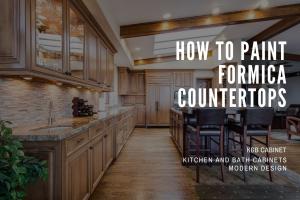Transform Your Kitchen: The Ultimate Guide to Painting Formica Countertops

-
Quick Links:
- Introduction to Formica Countertops
- Why Paint Formica Countertops?
- Materials Needed for Painting Formica
- Preparing Your Formica Countertops
- Step-by-Step Guide to Painting Formica Countertops
- Finishing Touches and Maintenance
- Expert Insights and Case Studies
- FAQs
Introduction to Formica Countertops
Formica countertops are a popular choice in many homes due to their affordability and durability. Unlike natural stone, Formica is a synthetic material made of layers of resin and paper, making it resistant to stains and easy to clean. However, over time, these countertops can become dull or outdated, leading many homeowners to seek ways to rejuvenate their surfaces.
Why Paint Formica Countertops?
Painting Formica countertops offers a cost-effective solution for homeowners looking to update their kitchen or bathroom without the hefty price tag of a full renovation. The benefits of painting Formica include:
- Cost-Effective: Painting is significantly cheaper than replacing countertops.
- Customization: Homeowners can choose colors and finishes that match their personal style.
- Quick Update: The process can often be completed in a weekend.
Materials Needed for Painting Formica
Before diving into the painting process, gather the necessary materials:
- High-quality primer (preferably bonding primer)
- Latex or acrylic paint suitable for countertops
- Clear topcoat for durability
- Sandpaper (150-grit and 220-grit)
- Paintbrushes and rollers
- Drop cloths
- Painter's tape
- Cleaning supplies (soap and water, degreaser)
Preparing Your Formica Countertops
Preparation is key to achieving a successful paint job. Follow these steps:
- Clean the Surface: Use soap and water to thoroughly clean the countertop, removing any grease or residue.
- Sanding: Lightly sand the surface with 150-grit sandpaper to create a rough surface for better paint adhesion.
- Tape Off Edges: Use painter's tape to protect walls, cabinets, and appliances from paint splatter.
Step-by-Step Guide to Painting Formica Countertops
Now that your countertops are prepped, it’s time to start painting!
Step 1: Priming
Apply a thin layer of bonding primer using a paintbrush or roller. This step is crucial as it helps the paint adhere better to the Formica surface.
Step 2: Painting
After the primer has dried, apply the first coat of paint. Use long, even strokes to ensure a smooth finish. Allow the first coat to dry completely before applying a second coat.
Step 3: Topcoat Application
Once the paint is dry, apply a clear topcoat to protect the painted surface from scratches and stains. This will also enhance the longevity of your painted countertops.
Finishing Touches and Maintenance
After the final coat has dried, remove any painter's tape carefully. To maintain your newly painted Formica countertops:
- Use cutting boards to prevent scratches.
- Wipe spills immediately to avoid damage.
- Avoid harsh chemicals; instead, use mild soap and water for cleaning.
Expert Insights and Case Studies
Many homeowners have successfully painted their Formica countertops, transforming their kitchens at a fraction of the cost of replacement. According to a 2022 survey by Home Improvement Magazine, 78% of DIYers reported satisfaction with their painted countertops, noting that they felt a renewed sense of pride in their kitchen space.
For example, Sarah, a homeowner from Ohio, shared her experience: "Painting my Formica countertops was the best decision I made for my kitchen. I chose a bright white color, and it completely changed the look of the space!"
FAQs
1. How long does it take to paint Formica countertops?
The entire process can take anywhere from a few hours to a couple of days, depending on drying times between coats.
2. Can I use regular paint for Formica countertops?
No, it’s essential to use paint specifically designed for countertops or high-adhesion latex paint.
3. Is painting Formica countertops durable?
Yes, when done correctly and with proper maintenance, painted Formica countertops can be quite durable.
4. Can I use a spray paint for Formica?
Spray paint can be used, but it requires careful application to avoid overspray and drips.
5. How do I ensure the paint adheres well?
Proper surface preparation, including cleaning and sanding, is crucial for ensuring good paint adhesion.
6. What kind of topcoat should I use?
Acrylic or polyurethane topcoats are recommended for added durability and protection.
7. Can I paint over existing paint on Formica?
Yes, but you should sand the surface and ensure it is clean before applying new paint.
8. How do I fix mistakes in painted Formica countertops?
If you make a mistake, allow the area to dry, sand it lightly, and repaint.
9. What colors are best for painting Formica countertops?
Light colors can make a small space feel larger, while darker colors can add depth and sophistication.
10. Can I use a heat source on painted countertops?
It’s best to avoid direct heat on painted surfaces as it can damage the paint. Always use trivets or hot pads.
Random Reads
- How to install arch linux
- How to tar a directory linux
- How to use a water level
- How to use air compressor
- Received by line haul office aliexpress
- Rebuild ps4 ps5 database
- Mastering audacity
- Mastering auto numbering in excel
- How to make a copy of a key simple duplicating methods
- How to make a computer diary